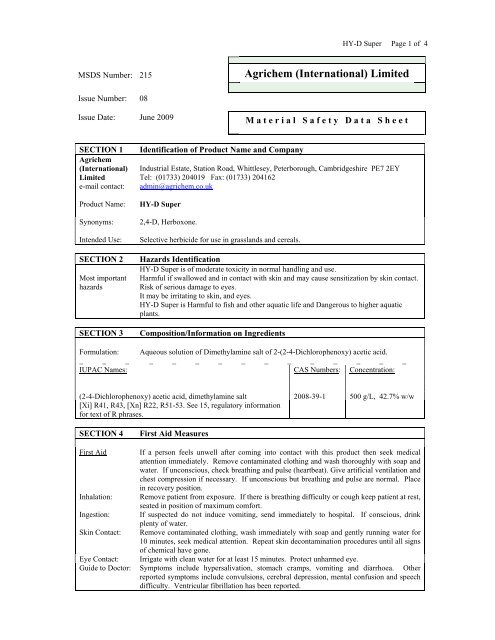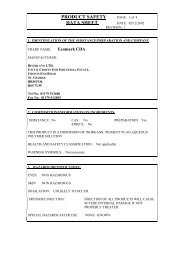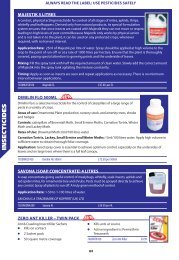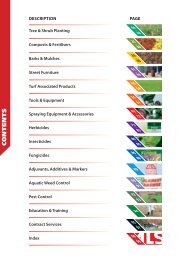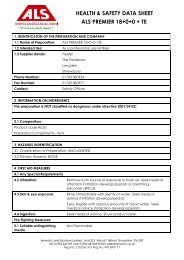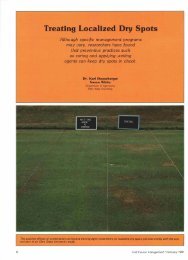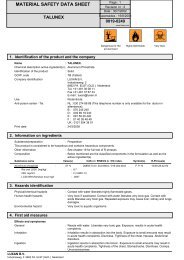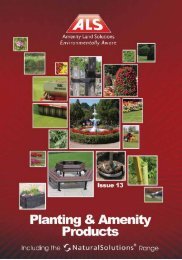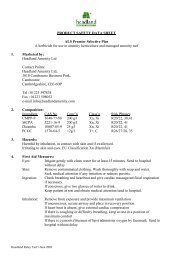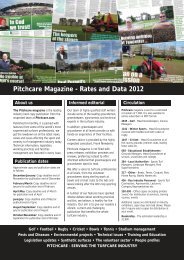Agrichem (International) Limited - Pitchcare
Agrichem (International) Limited - Pitchcare
Agrichem (International) Limited - Pitchcare
Create successful ePaper yourself
Turn your PDF publications into a flip-book with our unique Google optimized e-Paper software.
HY-D Super Page 1 of 4MSDS Number: 215<strong>Agrichem</strong> (<strong>International</strong>) <strong>Limited</strong>Issue Number: 08Issue Date: June 2009 M a t e r i a l S a f e t y D a t a S h e e tSECTION 1<strong>Agrichem</strong>(<strong>International</strong>)<strong>Limited</strong>e-mail contact:Product Name:Synonyms:Intended Use:SECTION 2Most importanthazardsSECTION 3Identification of Product Name and CompanyIndustrial Estate, Station Road, Whittlesey, Peterborough, Cambridgeshire PE7 2EYTel: (01733) 204019 Fax: (01733) 204162admin@agrichem.co.ukHY-D Super2,4-D, Herboxone.Selective herbicide for use in grasslands and cereals.Hazards IdentificationHY-D Super is of moderate toxicity in normal handling and use.Harmful if swallowed and in contact with skin and may cause sensitization by skin contact.Risk of serious damage to eyes.It may be irritating to skin, and eyes.HY-D Super is Harmful to fish and other aquatic life and Dangerous to higher aquaticplants.Composition/Information on IngredientsFormulation: Aqueous solution of Dimethylamine salt of 2-(2-4-Dichlorophenoxy) acetic acid._ _ _ _ _ _ _ _ _ _ _ _ _ _ _IUPAC Names: CAS Numbers: Concentration:(2-4-Dichlorophenoxy) acetic acid, dimethylamine salt 2008-39-1 500 g/L, 42.7% w/w[Xi] R41, R43, [Xn] R22, R51-53. See 15, regulatory informationfor text of R phrases.SECTION 4First Aid MeasuresFirst Aid If a person feels unwell after coming into contact with this product then seek medicalattention immediately. Remove contaminated clothing and wash thoroughly with soap andwater. If unconscious, check breathing and pulse (heartbeat). Give artificial ventilation andchest compression if necessary. If unconscious but breathing and pulse are normal. Placein recovery position.Inhalation: Remove patient from exposure. If there is breathing difficulty or cough keep patient at rest,seated in position of maximum comfort.Ingestion: If suspected do not induce vomiting, send immediately to hospital. If conscious, drinkplenty of water.Skin Contact: Remove contaminated clothing, wash immediately with soap and gently running water for10 minutes, seek medical attention. Repeat skin decontamination procedures until all signsof chemical have gone.Eye Contact: Irrigate with clean water for at least 15 minutes. Protect unharmed eye.Guide to Doctor: Symptoms include hypersalivation, stomach cramps, vomiting and diarrhoea. Otherreported symptoms include convulsions, cerebral depression, mental confusion and speechdifficulty. Ventricular fibrillation has been reported.
HY-D Super Page 2 of 4SECTION 5Fire Fighting MeasuresFumes may be toxic - wear breathing apparatus.Extinguish with waterspray, dry chemical, foam or Carbon dioxide .Product may be harmful to wildlife - DO NOT release chemically contaminated water intodrains, soil or surface water - prevent run off. Retain for safe disposal.SECTION 6Personalprotection:Environmentalprecautions:Spillage andDecontamination:Accidental Release MeasuresAvoid contact with skin, eyes, or clothing. Do not inhale mists, aerosols or dusts. Avoidingestion. Wear suitable protective clothing, boots, gloves, eye and face protection.Do NOT contaminate surface waters or ditches with chemical or used containers.Minimise spray drift onto adjoining fields or water bodies.Contain and absorb spillage with sand, sawdust or similar material. Dispose of viareputable contractor or local authority.Do not allow spillage to contaminate water courses or drains.NB. Inform local Water PLC immediately if spillage enters drains, and report anycontamination of surface water of ground waters to the National Rivers Authority or RiverPurification Board.SECTION 7Handling:Storage:Packing:SECTION 8Nationaloccupationalexposure limitsEngineeringcontrols:Respiratoryprotection:Hand protection:Eye protection:Hygienemeasures:Handling and StorageEnsure there is sufficient ventilation of the area. Avoid contact with skin/eyes. Do NOTinhale mists. Avoid ingestion.When using do not eat, drink or smoke.Wash hands and exposed skin before meals and after work.Store and load away from foodstuffs and seeds.Keep tightly closed in original container and store in a suitable pesticide store.5 litre plastic cans. 4 x 5L per outer. Gross weight pack 23kg and freestanding 10Ljerrican.Exposure Controls/Personal ProtectionNone assigned in current UK HSE publication EH40. Based on the value for the technical2,4D acid the calculated salt equivalent long term limit is 12mg/m 3 (8hr), or 24mg/m 3 (15min).Ensure there is sufficient ventilation of the area.Wear suitable protective clothing (coveralls), suitable protective gloves, rubber boots andface protection (faceshield) when handling contaminated surfaces.Wear suitable respiratory protective equipment (faceshield) to avoid exposure toconcentrate or mist.Wear suitable protective gloves (EN 374:1994) when handling the concentrate.Wash concentrate from skin immediately.Wear suitable eye/face protection.Handle in accordance with good industrial hygiene and safety practice. Shower or bathe atthe end of working.
HY-D Super Page 3 of 4SECTION 9Appearance:Odour:Physical and Chemical PropertiesLight brown liquidDistinctive phenoxy odourMelting Point: not applicable Oxidising properties: None knownBoiling Point: >100°C Solubility in Water: Fully miscible in waterpH: 7.5-9.5 Solubility in OrganicSolvents:No dataFlash Point: not applicable Par. Coeff. N-octanol/water. No dataFlammability: No dataExplosive properties: stable product Vapour Density: No dataDensity: 1.0 g/ml at 20 o C Vapour Pressure No dataSECTION 10Stability and ReactivityConditions to avoid:Materials to avoid:Hazardous combustion or decomposition products:Strong bases, strong acids and oxidising agents.Carbon monoxide, carbon dioxide, nitrogenoxides(NO x ), hydrogen chloride gas.SECTION 11ACUTE TOXICITYInhalation:Inhalation LC 50 :Ingestion:Skin Contact:Dermal LD 50 :Eye Contact:Further information:Toxicological InformationClassified by Chemicals (Hazard Information and Packaging forSupply)Regulations as Harmful by Inhalation4hour rat >5.01mg/l.Harmful if Swallowed. LD 50 /oral/rat = 1297mg/kg (males andfemales).Classified by Chemicals (Hazard Information and Packaging forSupply)Regulations as Harmful in Contact with Skin.Dermal rat = >4000 mg/kgRisk of Serious Damage to Eyes.Not carcinogenic, mutagenic or teratogenic.SECTION 12Mobility:Persistence anddegradability:Bioaccumulativepotential:Ecological InformationHY-D Super is classified as Harmful to fish or other aquatic life and Dangerous to higheraquatic plants.Fairly mobile, but rapidly degraded in aerobic soils.Rapidly degraded in aerobic soils (aerobic half life 2,4-D = 3-10 days).Potential for bioaccumulation is low based on log Pow. (log Pow 2,4-D = 0.91 at pH7).LC 50 96hr Rainbow Trout = >200mg 2,4-D DMA/l & 72hr algae = 178mg 2,4-D DMA/l.EC 50 48hr Daphnia = > 200mg 2,4-D DMA/l.
HY-D Super Page 4 of 4SECTION 13Waste Disposal:(includingcontainers)SECTION 14Disposal ConsiderationsBy incineration in accordance with the current UK legislation. For minor incidents orunwanted product follow the guidance of the disposal of pesticides and containers as givenin part 5 of the MAFF/HSE Pesticide Code of Practice for the safe use of Pesticides onFarms and Holdings.Transport InformationHazard Symbol : Xn N Dangerous for the HARMFULEnvironmentUN Number: 3082 Environmentally HazardousSubstancePacking Group:SeaIMDG Class-primary: 9 Environmentally Hazardous SubstanceProper Shipping Name: ENVIRONMENTALLY HAZARDOUS SUBSTANCE, LIQUID, N.O.S.(contains 2,4-D 47%)EMS Number: noneMFAG Table Number: noneRoad/Rail Class 9 HI No 90. Air IATA: Class 9.ADR/RIDENVIRONMENTALLY ENVIRONMENTALLYHAZARDOUS SUBSTANCE, HAZARDOUS SUBSTANCE,LIQUID, N.O.S.LIQUID, N.O.S.Packing Group lllPacking Group lllIIISECTION 15 Regulatory InformationClassified according to the 2009 UK Chemicals (Hazard Information and Packaging Regulations) CHIP 4Regulations.Xn Harmful. Xi Irritant. N Dangerous for the Environment (see symbols above)Risk Phrases: R22R41R43R51/53Harmful if swallowed.Risk of Serious damage to eyesMay cause sensitization by skin contact.Toxic to aquatic organisms, may cause long term adverse effects in theaquatic environmentSafety Phrases: S24/25S26S35S39S46S57S61MAPP No 13198Avoid contact with skin or eyes.In case of contact with eyes, rinse immediately with plenty of water andseek immediate medical advice.This material and its container must be disposed of in a safe way.Wear eye/face protection.If swallowed, seek medical advice immediately and show this container orlabel.Use appropriate containment to avoid environmental contamination.Avoid release into the environment. Refer to special instructions/safety datasheet.SECTION 16Other InformationNoneThe data given in this sheet is based on current knowledge and experience and is given in good faith butwithout guarantee of accuracy and no liability is accepted whatsoever for any insufficiency or inaccuracy insuch data in any case whatsoever.The purpose of the Material Safety Data Sheet is to describe the products in terms of their safety requirements.The data does not signify any warranty with regards to materials, properties or use.


